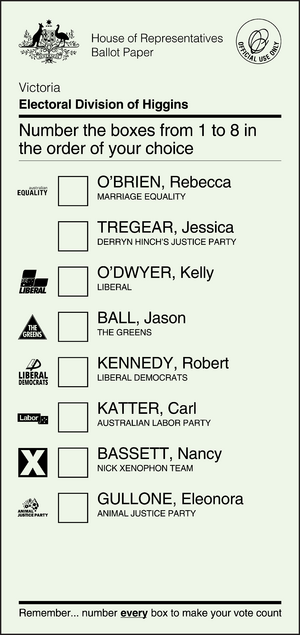Instant Runoff Voting facts for kids
Instant runoff voting is a special way to choose one winner from a group of more than two people. It's often used to elect politicians, but it can also help groups make other big decisions. Instead of just picking one person, voters rank all the candidates from their favorite (number 1) to their least favorite.
The votes are counted in a series of make-believe rounds. If no candidate gets more than half of the votes in a round, the person with the fewest votes is removed. Then, the votes from those who chose the removed person are given to their next favorite candidate. This process keeps going until one candidate gets a majority (more than half) of the votes.
Contents
Where is Instant Runoff Voting Used?
Instant runoff voting has been used in Australia for over 80 years to elect members to their main parliament. In Australia, two main political parties are usually very strong. This voting method is also used in some cities in the United States to choose mayors. When this system is used, about the same number of people vote as in other common voting systems.
Why Some People Like It
Voting for Your True Favorite
Many people who support instant runoff voting believe it lets them vote for the candidate they truly like the most. They feel they can do this without worrying that their vote will be "wasted." If their top choice doesn't win, their vote can still help another candidate they like, especially if it's between two candidates they don't love.
Changing the Political System
Supporters also think this system helps voters show their real choices. They believe it can make it easier for new parties or candidates to challenge the usual two big parties. When there are more candidates to choose from, it might be harder for the same people to stay in office for a long time.
Why Some People Don't Like It
Tricky Voting Choices
Some people who don't like instant runoff voting say it can be complicated. If three or more candidates have a good chance of winning, voting for your absolute favorite might accidentally cause a "compromise" candidate (someone many people could agree on) to lose early on. Then, your favorite might lose to someone you like even less in a later round.
How Votes Transfer
Another concern is that your vote can't always transfer exactly how you might want. For example, if your second favorite candidate is removed before your first favorite, your vote won't go to your second choice. Sometimes, voters might still choose a "compromise" candidate as their first choice, just like in other voting systems.
Counting the Votes
While the idea of instant runoff voting seems simple, counting the votes can be tricky. Because the order you rank candidates matters so much, it often needs computers to count all the ballots correctly. Some people worry about using computers for counting votes because it can be hard for regular citizens to check the results by hand and make sure everything is fair. They also point out that a candidate getting fewer votes doesn't always mean they are unpopular. It might mean they didn't fit neatly into one side of the political discussion. This system can sometimes even lead to middle-ground candidates being eliminated in the final rounds.
Images for kids
-
The Australian Electoral Commission holding a blind ballot to determine the order of candidates on the ballot paper, 2004
See also
 In Spanish: Segunda vuelta instantánea para niños
In Spanish: Segunda vuelta instantánea para niños





